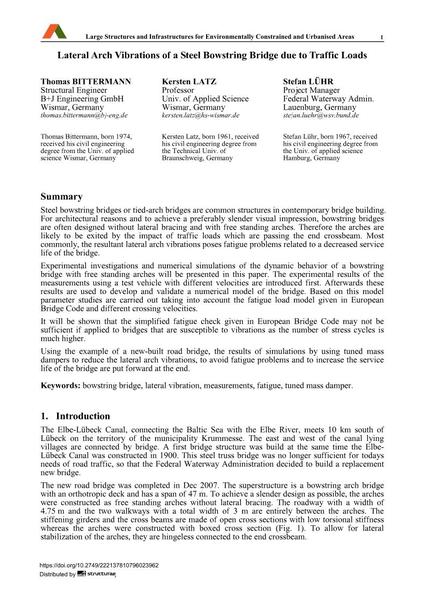Lateral Arch Vibrations of a Steel Bowstring Bridge due to Traffic Loads

|
|
|||||||||||
Bibliografische Angaben
| Autor(en): |
Thomas Bittermann
Kersten Latz Stefan Lühr |
||||
|---|---|---|---|---|---|
| Medium: | Tagungsbeitrag | ||||
| Sprache(n): | Englisch | ||||
| Tagung: | IABSE Symposium: Large Structures and Infrastructures for Environmentally Constrained and Urbanised Areas, Venice, Italy, 22-24 September 2010 | ||||
| Veröffentlicht in: | IABSE Symposium Venice 2010 | ||||
|
|||||
| Seite(n): | 154-155 | ||||
| Anzahl der Seiten (im PDF): | 8 | ||||
| Jahr: | 2010 | ||||
| DOI: | 10.2749/222137810796023962 | ||||
| Abstrakt: |
Steel bowstring bridges or tied-arch bridges are common structures in contemporary bridge building. For architectural reasons and to achieve a preferably slender visual impression, bowstring bridges are often designed without lateral bracing and with free standing arches. Therefore the arches are likely to be exited by the impact of traffic loads which are passing the end crossbeam. Most commonly, the resultant lateral arch vibrations poses fatigue problems related to a decreased service life of the bridge. Experimental investigations and numerical simulations of the dynamic behavior of a bowstring bridge with free standing arches will be presented in this paper. The experimental results of the measurements using a test vehicle with different velocities are introduced first. Afterwards these results are used to develop and validate a numerical model of the bridge. Based on this model parameter studies are carried out taking into account the fatigue load model given in European Bridge Code and different crossing velocities. It will be shown that the simplified fatigue check given in European Bridge Code may not be sufficient if applied to bridges that are susceptible to vibrations as the number of stress cycles is much higher. Using the example of a new-built road bridge, the results of simulations by using tuned mass dampers to reduce the lateral arch vibrations, to avoid fatigue problems and to increase the service life of the bridge are put forward at the end. |
||||
| Stichwörter: |
Ermüdung
|
||||
